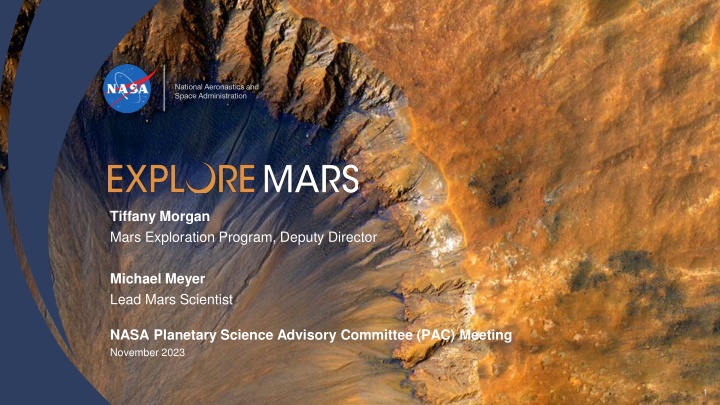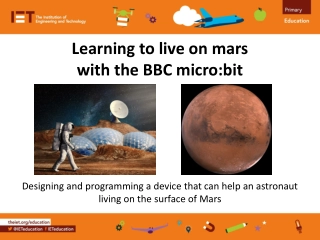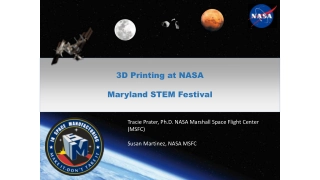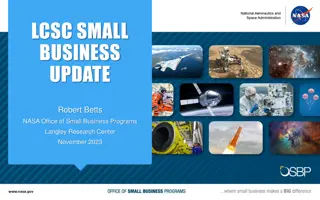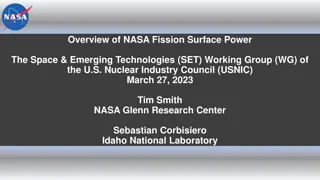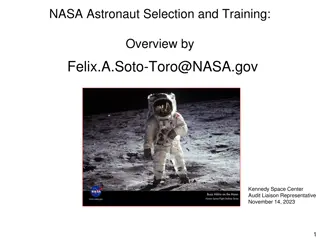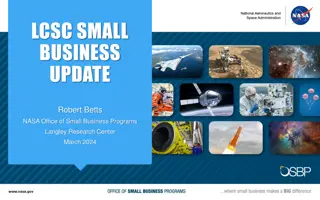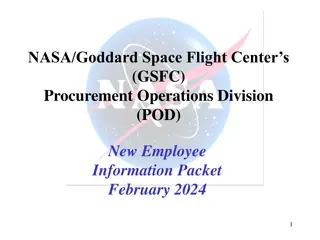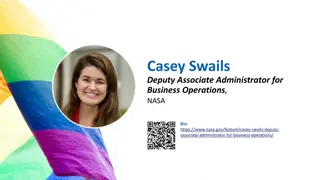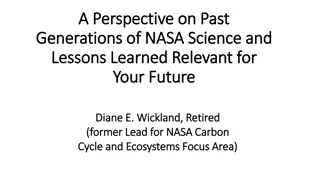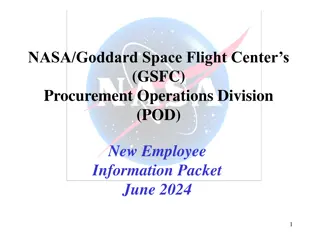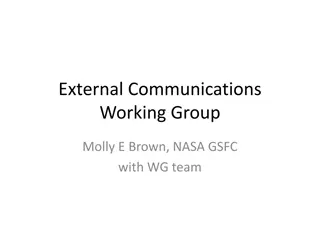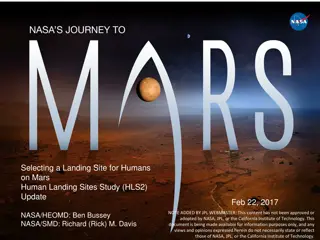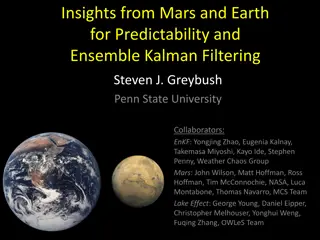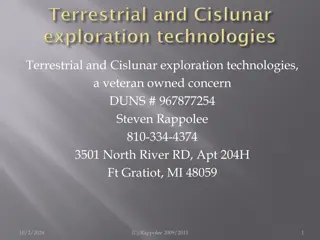Latest Updates on NASA Mars Exploration Programs
Discover the latest developments in NASA's Mars Exploration Program, including highlights from the Curiosity rover, upcoming events, future planning activities, and progress on the Rosalind Franklin Mission collaboration with ESA. Get insights on community engagement, technology studies, industry infrastructure, and the search for life on Mars. Stay informed about key missions, collaborations, and advancements in space exploration.
Download Presentation

Please find below an Image/Link to download the presentation.
The content on the website is provided AS IS for your information and personal use only. It may not be sold, licensed, or shared on other websites without obtaining consent from the author.If you encounter any issues during the download, it is possible that the publisher has removed the file from their server.
You are allowed to download the files provided on this website for personal or commercial use, subject to the condition that they are used lawfully. All files are the property of their respective owners.
The content on the website is provided AS IS for your information and personal use only. It may not be sold, licensed, or shared on other websites without obtaining consent from the author.
E N D
Presentation Transcript
National Aeronautics and Space Administration Tiffany Morgan Mars Exploration Program, Deputy Director Michael Meyer Lead Mars Scientist NASA Planetary Science Advisory Committee (PAC) Meeting November 2023 1
Mars Exploration Program Highlights - Curiosity arrived at Gediz Valley Ridge! - IMEWG In-person, Tokyo 7-10 Nov, 2023 - MAVEN 10 Year Launch Anniversary! Party @ GSFC Nov 20, 2023 - Mars Solar Conjunction ~Nov 11-25, 2023 - MDAP 2023 Step-1 submittals increased by ~30% from the recent declining trend; almost back to 2020 levels Step-2 proposals due Nov 16, 2023 Review panel planned for Feb-Mar 2024 - Mars 2020 Participating Scientist Program (PSP) Due to budget challenges, there will not be a new solicitation 2
MEP Future Plan Activities Community Engagement Recent/Upcoming draft plan community presentations to solicit feedback Astrobiology Townhall, SmallSat Conf, Industry Briefing, Mars Society, AAS DPS, ASCEND, IMEWG, AGU Industry Infrastructure/Technology Studies Commercial services Guiding Principles and Design Reference Mission scenarios feedback solicited Release of MEP Industry Studies RFP in late winter/early spring 2024 Search For Life Planning MEP is working with the Astrobiology program to charter a Search for Life (SFL) - Science Analysis Group (SAG) Incorporate past activities across different communities into a coherent effort Prioritize desired Martian broad-scale environments to search for extant life Identify Technology development required to search for life in specified environments Planning to begin SFL-SAG member selection in early 2024 Terms of Reference (ToR) draft underway Considering workshop(s) focused on the specific science and technology needs in spring/summer 2024, with a final report anticipated by the end of 2024 3
Rosalind Franklin Mission Collaborating with ESA to ensure RFM has all essential elements for a 2028 Launch ESA Check Point Review late-November 2023 for mission procurement approval Continuing MOMA-MS* preparations for launch PH power card replacement in process for risk reduction *Mars Organic Molecule Analyser Mass Spectrometer Launch Service Preparing for acquisition of launch vehicle via NLS-II contract action Lander Descent Engines Procuring Long Lead Items from Aerojet & MOOG Radioisotope Heater Units (RHUs) NASA is working with the Department of Energy to restart production of RHUs that will heat the rover Credit: ESA 4
Sample Receiving Project Measurement Definition Team (MDT) Developing strawman set of instruments needed within the high-containment facility to accomplish sample safety assessment, curation, and science 23 selected of 147 applicants, plus 6 ex-officio members Report expected in April 2024 The SRP is the final element of the MSR Campaign that has a defined mission to recover, contain, transport, assess safety of, curate and scientifically investigate the samples returned to Earth by MSR Primary Goal: Enable safe and rapid release of the returned samples to world-wide labs for science investigations Returned Sample Safety Assessment Developing protocol to determine if returned samples pose a hazard to Earth s biosphere and are safe to release from high-containment laboratories Kick-off meeting held Sept 2023 Coordinating with MDT to ensure alignment with instrument and measurement recommendations Interim report in Dec 2023; Final report in Mar 2024 Investigating potential partnerships and collaboration opportunities for the Sample Receiving Facility 5
MEP Orbiters Mars Relay Network (MRN) MEP successfully managing network activities with aging orbiters that are well into their extended missions Spacecraft are operating nominally with instruments functioning properly Projects are managing all consumables to extend science and relay operations Odyssey Results of propellant investigation now estimates remaining propellant at 4 kg +/- 2 kg, usage 1 kg/year Project began its 9th extended mission in October 2022 MAVEN No safe mode events since Feb 2023 MAVEN operating in all-stellar attitude sensing mode to preserve lifetime of remaining IMU Project began its 5th extended mission in October 2022 MRO No safe mode events since Nov 2022 Project began its 6th extended mission in October 2022 ExoMars/TGO Continuing to support relay operations for MEP; returning >50% relay data of landed assets MAVEN s Imaging Ultraviolet spectrograph (IUVS) instrument obtained these infrared views of Mars when the planet was near opposite ends of its elliptical orbit. Credit: NASA/LASP/CU Boulder 6
Mars 2020 Margin Campaign Perseverance Odometer: 22.98 km* Ingenuity Log: 66 flights, 14.9 km* * As of November 7, 2023 Delta Top Campaign Three Forks Ingenuity Flt 66, NavCam Image Credit: NASA/JPL-Caltech Annotated composite image shows the path Perseverance took through a dense section of boulders. The pale blue line indicates the course of the center of the rover s front wheel hubs, while the darker blue lines show the paths taken by the bottom of the rover s six wheels. Credit: NASA/JPL-Caltech 7
Upper Fan & Margin Unit Campaigns: Tubes 22-26 As of Nov 2, 2023 METERS 200 17 17 DREAM DREAM LAKE LAKE EMERALD EMERALD LAKE LAKE LEFROY BAY LEFROY BAY BILLS BAY BILLS BAY CORE20 SOL942 CORE20 SOL942 ABRADE SOL935 ABRADE SOL935 AMHERST AMHERST POINT POINT GABLETOP GABLETOP MOUNTAIN MOUNTAIN PELICAN PELICAN POINT POINT PILOT MOUNTAIN PILOT MOUNTAIN TENBY TENBY CORE18 SOL882 CORE18 SOL882 ABRADE SOL915 ABRADE SOL915 CORE19 SOL923 CORE19 SOL923 16 16 ABRADE SOL877 ABRADE SOL877
Latest Perseverance Sample: Lefroy Bay Contains 1stconfirmed presence of hydrated silica cement & hydrated carbonates Potential good preservation media for biosignatures Possible unique hydrated Mg sulfate and candidate phosphate or perchlorate detection Record of a distinct habitable environment different from the delta front and upper fan Opportunity to ground truth high-carbonate hot spot that led us to this outcrop by the CRISM data 9
MSR Campaign Science Organization Current community science team Dual Agency Leadership MSR Campaign Science Executive Group MSR Science Leadership MSR Campaign Science Group (MSCG) MSR Lead Scientist Gerhard Kminek MSR Lead Scientist Michael Meyer Current internal SRP science team M2020 PS Ken Farley MSR PS Mini Wadwha NASA SRP PS Dave Beaty ESA SRP PS Elliot Sefton-Nash Joint Science Office (JPL/ESA/JSC) NASA & ESA Project Scientist (PS) Deputy Project Scientists Staff NASA/ESA Jointly Managed NASA Appointed M2020 Science Office/Team MSR Program Science Office ESA Appointed Subject Specific Working Groups (e.g., SRF Contamination Panel, Rock Team, Gas Team) Externally Selected Programmatic Relationship Direct Reporting Relationship
Notional Plan for SRP Science Team Regardless of phase, a science group will always be in place to participate in relevant activities AO 1 will cover large instruments that need to be installed in the SRF during construction. AO 2 includes all other instruments both inside and outside the SRF. PSG is sourced from SRP science team alongside project scientists Until AO-2, the community is represented by the MCSG FY24 FY25 FY26 FY27 FY28 FY29 FY30 FY31 FY32 FY33 FY34 FY35 FY36 MCSG1 SRP Science Team (Draft name: MSST) R&A Activities Sample Science Community sourced science teams Sample Arrival AO 1 MDT-1 AO 2 MDT-2 Key milestones SRP Joint Science Office SRP PSG (Draft name: MCSG2) Science management 11 Pre-Decisional - For planning and discussion purposes only
Mars Science Laboratory (MSL) Curiosity Curiosity arrived at Gediz Vallis ridge August 14th! After three years, we finally found a spot where Mars allowed Curiosity to safely access the steep ridge, Ashwin Vasavada (Project Scientist) commenting on reaching the ridge after previous attempts were thwarted by gator-back rocks and steep slopes Curiosity acquired a drilled sample from light-toned bedrock found in the dark-light interlayered bands of the magnesium sulfate-bearing unit. This is the 3rddrill sample since encountering the unit ~115 vertical meters below, and 39thdrill sample overall. Gediz Vallis Ridge Layered Magnesium Sulfate- Bearing Unit NASA s Curiosity captured this panorama while parked below Gediz Vallis Ridge (seen at right), a formation that preserves a record of one of the last wet periods seen on this part of Mars. After previous attempts, the rover finally reached the ridge on its fourth try. Credits: NASA/JPL-Caltech/MSSS 12
MRO MARCI Clouds The MRO MARs Color Imager (MARCI) observes Mars to build a global picture of the weather on Mars each day Condensate clouds play an important role in Mars energy balance, both reflecting incident solar radiation and trapping heat emitted by the surface Active local, deep vertical transport in the Mars atmosphere is shown in this image as afternoon mesospheric condensate clouds above Sinai Planum in the Southern Tropics This autumn cloud phenomena reached heights greater than 50 km as determined from shadow length measurements The checkerboard cloud pattern is indicative of organized thermal convection. The location of the clouds on the southern boundary of the Noctis Labyrinthus valley and canyon network suggests that upslope flow is working in conjunction with thermal convection to explain how the pattern formed at altitude. 13
with us 14
Inputs into MSR Sample Science Planning The darkness of the blue indicates extent of coverage for that category. Unless noted, all categories refer to the samples, e.g., Sample Management. 15
